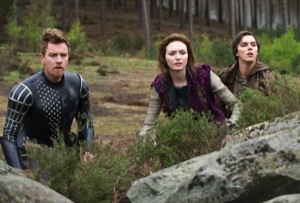
During the first third of so of Jack the Giant Slayer, among the battalion who accompany Jack on the quest to rescue the princess and kill some giants is one particularly handsome, rather strapping bald-headed knight who has a couple of lines before meeting his demise. While I was reading through the IMDb page for the film, I saw his picture, discovered the actor is named Mingus Johnston, and his character is named Bald. This, in a microcosm, is what’s wrong with Jack the Giant Slayer: it’s as obvious as its fairy tale source and as creative as, well, naming the one bald character “Bald.” With a budget of $195 million, I would think producer and director Bryan Singer would have been able to afford an original idea.
While the title of the film makes it sound like it is based on the old English folk tale Jack the Giant Slayer, it’s actually based on that story crossed with the better known and closely allied fairy tale Jack and the Bean Stalk. The differences between the stories are probably mostly important only to folklorists, so I’ll just explain the combined plot.
In medieval England, Jack (a fine, dashing Nicholas Hoult), the nephew of a poor farmer, goes to the local castle to sell their horse for needed gold. While he’s there, a monk steals the infamous magic seeds from the king’s scheming, but trusted adviser Lord Roderick (Stanley Tucci, doing what he does). During the monk’s escape, the monk runs into Jack and convinces him to trade the seeds for the horse.
After coming home with a baggy of beans, Jack is scolded by his irate uncle. That night, after a fight with her father the king (Ian McShane), Princess Isabel (Eleanor Tomlinson) runs away. A storm comes and she ends up sheltering at Jack’s house just when the rain water activates one of the seeds. The eruption of monster vines propels Jack’s house into the sky; he escapes but Isabel doesn’t. The king sends his battalion of guardians, led by the dashing and vague Elmont (Ewan McGregor, charismatic, deadpan, underused), up the beanstalk with Jack and dastardly Lord Roderick. At the top, they find a land of mean, hungry-for-humans giants. Jack and Elmont just want to save Isabel, but Roderick has other ideas.
While the film’s plot has some minor surprises, mostly involving killing off characters played by famous actors earlier than later, the actual screenplay, cobbled together by four occasionally talented writers not doing even their most mediocre work, is a series of clichéd lines (Jack: What are you running away from? Princess Isabelle: Who says I’m running away from anything? Maybe I’m running toward something), stereotyped characters (Roderick is an effeminate villain, the giants are smart but inexplicably evil), and battle scenes only barely differentiated from those in, say, a hobbit movie.
Within this, Singer is still able to move the action along at a nice clip, keeping the sword fights, political intrigue and romance paced as needed, but also as expected. His hordes of special effects designers handle the giants, the bean stalk and the battle scenes more impressively, but the use of 3-D is perfunctory. I haven’t figured out why it’s being used so often. The cynic in me says that it’s just an excuse to upcharge $4 or $5, but I think it’s also possible someone, somewhere likes it. But aside from The Hobbit, Life of Pi, Hugo and Avatar, no one has ever made 3-D worthwhile.
Considering how uninteresting Jack the Giant Slayer is, I shouldn’t be surprised that the 3-D is so uninspired.
MOVIE REVIEW
Jack the Giant Slayer
Directed by Bryan Singer
Written by Darren Lemke, Christopher McQuarrie and Dan Studney
Starring Nicholas Hoult, Eleanor Tomlinson and Ewan McGregor
Rated PG-13
At your local multiplex












I dont like this movie